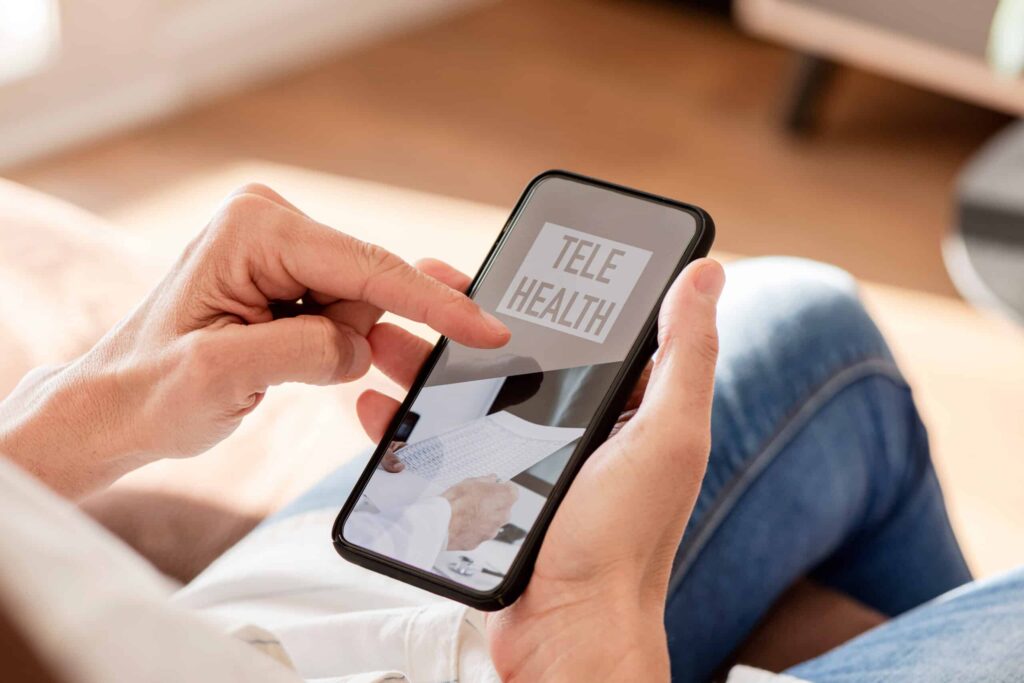The convenience of performing important tasks from home cannot be denied. Remote work, shopping, and more has reduced crowding and congestion in cities, and saved people on travel time and costs. Remote alternatives for healthcare have quickly became popular as well, especially during cold and flu season. Despite its popularity, remote healthcare is still a relatively new invention and there are many different ways to approach it. This article will help practices learn how to engage patients in telehealth in the most effective manner.
Telehealth trades in-person healthcare visits for remote appointments, allowing patients to get faster, more convenient healthcare. Meeting with a doctor over the phone or on video chat makes getting diagnoses and prescriptions for many conditions easy and painless, and is great for checking in on ongoing treatment progress. Telehealth has also proven especially useful in reaching geographically isolated or dispersed populations, such as those living in rural areas.
Serious or harder-to-diagnose problems require trips to see the doctor in person, but the more people stick to telehealth, the less crowded hospitals will be, making healthcare easier for all involved.
Telehealth and Patient Engagement
Of course, telehealth treatment is only effective if patients use the service. Many people are already not as proactive as they could be when it comes to seeing the doctor. Some stubborn types won’t make a doctor’s appointment until something is bleeding or broken. The high cost of healthcare in the United States can act as a powerful deterrent as well.
Telehealth practices can negate many of these disadvantages, but patients must be encouraged to change their habits and expectations and make better use of these services. That’s why building patient engagement is an absolute must for practices that plan to leverage telehealth to save their doctors, nurses, administrators, and patients the most possible time and effort.
Offering patients a remote alternative to in-person visits is especially powerful during cold and flu season. Patients who want to avoid waiting rooms packed with potential virus-spreaders are likely to choose telehealth over in-office visits. This makes telehealth a powerful tool for keeping patients engaged in their care at a time where many would be hesitant to visit your office for routine care.
Building patient engagement takes more than just good communication though good communication is absolutely a must. In our exciting and often highly distracting digital age, everyone has a thousand stimuli fighting for their attention at all times. Even something as important as health can fall by the wayside. Indeed, as telehealth makes healthcare easier to obtain, that ease can sometimes make people complacent and slower to participate.
Luckily, our digital age also has plenty of tools to help build patient engagement, and with the right strategy and the right online platform medical practices can keep patients invested and active in their healthcare.

4 Tips on How to Engage Patients in Telehealth
The road to fully engaging one’s patients in telehealth can seem long and confusing. The same breadth of options mentioned above can lead to some serious analysis paralysis and leave medical teams wondering where to start. Below is a list of tips to help care providers and their teams grab their patients’ attention and ensure people are making and keeping up a steady flow of telehealth appointments.
Following these instructions, and armed with the right software platform, practices will soon be sure their patients are well taken care of and healthy without having to come in to be seen in person every time something feels off.
Tip 1: Video chat
The first step is to understand and leverage a HIPAA-compliant video chat. People use video chat in all areas of their lives, and medicine should be no different. Indeed, medical care and video chat are a match made in heaven. Doctors can not only ask patients about their conditions, but look at high-fidelity video of any visible symptoms. This makes video chat extremely versatile, and provides nearly the same amount of patient/provider interaction as an in-person visit.
Medical practices should make their patients aware of the availability of video telehealth appointments, and of the inherent benefits. To ensure these benefits and more remain available, it is vital to implement a comprehensive telehealth software solution.
Make sure your video chat platform complies with HIPAA regulations, such as encrypting data both at rest and in transit. Several popular video chat services, including Zoom, have added features to meet HIPAA standards, but many providers find that a purpose-built medical video chat service is a better fit for their needs.
The best HIPAA-compliant video chat platforms make the following benefits available:
- Improved patient satisfaction: Patients receive quality care faster and more easily
- Increased revenue: Doctors can see more patients remotely than they can in person
- Better security and compliance: All information shared is protected, and all visits are HIPAA-compliant
- Seamless integration: Providers can access a shared patient directory that connects over 100 electronic health records (EHRs)
- Decreased no-shows: The average no-show rate is 7.5%, compared to 36.1% for in-office appointments.
Tip 2: Broadcast to current clients
Getting the word out about available telehealth services is the best way to keep patients informed and engaged. This means both big announcements about available COVID-19 testing or flu vaccine availability, individual reminders to make and attend appointments, or even sharing updated holiday office hours. Regular communication makes it easier for patients to stick to their healthcare plans, taking medicines on time as well as making and keeping appointments.
By using templates and automated messaging to target particular groups of patients, practitioners can save themselves time and effort, automating and targeting their information. Keeping clients up-to-date on the latest services can maximize awareness and drive both patient help and provider revenue.
The right software platform can make messaging patients easy and automatic, removing much of the busywork and upkeep to let providers focus on serving their patients. Such a platform should offer:
- One-way messaging: Save time for staff and patients by preventing needless replies
- Accessibility: Send messages to all patients, one patient, or a select group
- Automation: Schedule recurring reminders and subsequent messages
- Targeting: Select groups of recipients based on any detail, such as age, location, or medication
- Templates: A library of pre-written messages ready to complete and send
The right platform should make it easy to both keep patients aware of possible services, and assist anyone undergoing treatment to keep up with their regimen.
Tip 3: Patient appointment reminders before and after visits
More and more businesses are using text messaging and emails to help clients attend meetings on time. It’s a great way to keep people engaged and aware of their commitments and works especially well for medical treatment. Appointments with busy doctors can sometimes be scheduled months ahead of time, and missing an appointment could mean waiting months more to be seen.
A friendly reminder via text keeps patients aware of when they need to arrive and what materials to bring with them, saving everyone time and stress. The more these messages can be customized to each practice and patient, the more flexible and useful they are.
Look for a solution with a fully customizable patient appointment reminders feature. It’s also helpful to have a library full of flexible appointment reminder text templates like the following:
Hello <Name>, this is a reminder for your appointment next week with <Doctor/Practice Name> on <Date and Time>
Here are some tips on how best to use appointment reminder messaging:
- Send more than one reminder. Best practices recommend sending appointment reminders one week ahead then again one day in advance, as well as the morning of the appointment
- If you only opt for two reminders, three days in advance is the best timeframe to find a replacement appointment and reschedule
- Avoid messaging people too early in the morning people are more likely to go back to sleep and forget the message, or to be grumpy if they do make the appointment
- Send annual event exam reminders to keep patients engaged and aware you haven’t forgotten them
- Get a software platform that can automate appointment reminders, scheduling texts as soon as the patient makes an appointment
Automated messaging reduces no-shows for healthier patients, stronger revenues, and better doctor-patient communication; and allows staff to spend their time on other projects.
Tip 4: Secure texting
Since medical practices will already be texting clients, it’s worth exploring texting further as a tool for communication. Doctors and nurses can talk directly with patients via secure SMS, discussing basic issues like symptoms, medicine dosages, side effects, and more.
Younger (Millennial or Generation Z) patients especially will appreciate using their preferred method of communication with their doctors and consider such free access to their medical practitioners really convenient. Just be sure to practice moderation and not answer every text at all hours of the day to avoid burnout and preserve work-life balance.
Just remember: any communication between patients and practitioners is subject to privacy regulations like HIPAA. Medical SMS must be highly secure and compliant with any such regulations. Some platforms specifically provide HIPAA-compliant and secure SMS texting which is critical to providing practices with top security and ensuring texting is as safe and legally protected as it is convenient.

How Updox Helps Engage Patients in Telehealth
Adding a complete telehealth solution to your practice is the fastest and easiest way to engage your patients with telehealth services. Telehealth has been a major gift to the medical field, helping practices and patients alike. Updox offers the best way to harness this technology, delivering the best care possible through a comprehensive and secure communication platform.
See how a comprehensive telehealth solution from Updox can change your practice!





